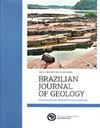Vegetation and climate changes in the forest of Campinas, São Paulo State, Brazil, during the last 25,000 cal yr BP
IF 0.9
4区 地球科学
Q3 GEOSCIENCES, MULTIDISCIPLINARY
引用次数: 4
Abstract
A paleoenvironmental reconstruction was performed in a Riparian Forest near Campinas to improve knowledge of paleoclimate and paleoenvironment in the State of São Paulo, Brazil. A sediment core of 182 cm depth was collected in a swamp located within a Cerrado/Seasonal Semi-deciduous ecotone forest. The chronological frame is given by eight radiocarbon dating methods. Pollen and stable isotope analyses (δ 13C and δ 15N) were performed all along the core. Modern pollen rain is based on five surface samples collected along the Riparian Forest. Results show a sequence of changes in vegetation and climate between 25 and 13 cal kyr before present (BP), and from 4 cal kyr BP to the present time, with a hiatus between 11 and 4 kyr cal BP. Drier climatic conditions characterized the late Pleistocene and early Holocene, although they had moisture peaks able to maintain an open forest. The Riparian Forest became fully installed from 4 cal kyr BP onward. Our results are in agreement with other regional studies and contribute to build a regional frame for past climatic conditions at the latitude of São Paulo.巴西圣保罗州坎皮纳斯森林的植被和气候变化,在过去25000 calyr BP
为了提高对巴西圣保罗州古气候和古环境的认识,对巴西坎皮纳斯附近的河岸森林进行了古环境重建。在塞拉多/季节性半落叶过渡林的沼泽中收集了182 cm深的沉积物岩心。时间框架由八种放射性碳测年方法给出。沿岩心进行了花粉和稳定同位素(δ 13C和δ 15N)分析。现代花粉雨是基于沿河岸森林收集的五个地表样本。结果表明,该区植被和气候变化序列为25 ~ 13 cal cal BP之前和4 cal cal BP至今,在11 ~ 4 cal BP之间有中断。晚更新世和全新世早期的气候条件较为干燥,尽管它们的湿度峰值能够维持开放的森林。河岸森林从4calkyr BP开始被完全安装。我们的研究结果与其他区域研究一致,并有助于为圣保罗纬度过去的气候条件建立一个区域框架。
本文章由计算机程序翻译,如有差异,请以英文原文为准。
求助全文
约1分钟内获得全文
求助全文
来源期刊

Brazilian Journal of Geology
GEOSCIENCES, MULTIDISCIPLINARY-
CiteScore
3.20
自引率
7.10%
发文量
12
审稿时长
11 weeks
期刊介绍:
The Brazilian Journal of Geology (BJG) is a quarterly journal published by the Brazilian Geological Society with an electronic open access version that provides an in-ternacional medium for the publication of original scientific work of broad interest concerned with all aspects of the earth sciences in Brazil, South America, and Antarctica, in-cluding oceanic regions adjacent to these regions. The BJG publishes papers with a regional appeal and more than local significance in the fields of mineralogy, petrology, geochemistry, paleontology, sedimentology, stratigraphy, structural geology, tectonics, neotectonics, geophysics applied to geology, volcanology, metallogeny and mineral deposits, marine geology, glaciology, paleoclimatology, geochronology, biostratigraphy, engineering geology, hydrogeology, geological hazards and remote sensing, providing a niche for interdisciplinary work on regional geology and Earth history.
The BJG publishes articles (including review articles), rapid communications, articles with accelerated review processes, editorials, and discussions (brief, objective and concise comments on recent papers published in BJG with replies by authors).
Manuscripts must be written in English. Companion papers will not be accepted.
 求助内容:
求助内容: 应助结果提醒方式:
应助结果提醒方式:


